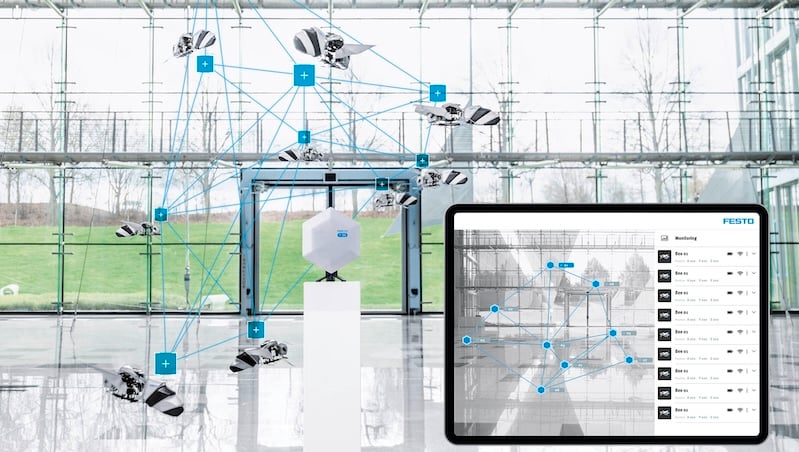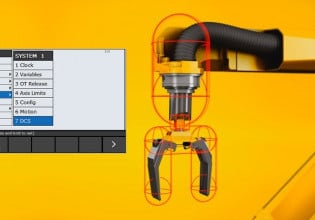Festo Creates a Buzz with Swarming Bees and Busy Bacteria
Taking cues from biology and putting bacteria to work are allowing Festo to develop new automation processes. These technologies were on display at Hannover Messe 2024.
Recently, Festo showcased several developments at Hannover Messe. However, innovations inspired by or using biology caught our attention: tiny swarming drones and bacteria for hydrogen processing.
Bionic Swarm–Capable Bees
If you thought the world of industrial automation couldn’t ‘bee’ any cooler, take a peek at Festo’s latest winged creation. The BionicBee is the smallest and first autonomous flying object able to swarm.

The ultralight BionicBee provides precise flight control. Image used courtesy of Festo
The tiny drone is only 22 mm long and weighs about 34 g. With a wingspan of 24 mm, it supports a wingbeat frequency of 15 to 20 Hz.
The developers of the BionicBee used generative design to formulate the most suitable structure based on a set of parameters and design principles. The BionicBee was designed to minimize material waste and use a lightweight frame for optimal aerial maneuverability.
Bee swarms can behave autonomously using an indoor location system with ultra-wideband (UWB) technology. This system consists of eight UWB anchors arranged strategically on two levels, and individual bees may precisely measure time and ascertain their locations within the area.

Festo’s Bionic Learning Network uses ultra-wideband to support BionicBee swarming. Image used courtesy of Festo
The bees follow predetermined flight patterns under the direction of a central computer, which makes precise timing and space management necessary to avoid collisions. After a test flight, every bee is automatically calibrated to optimize its flying parameters and account for manufacturing variations. Despite individual disparities among the bees, the program takes into account hardware changes to ensure continued centralized oversight of the complete swarm.
Bacteria Enable Safer Hydrogen Storage and Transport
In addition, Festo has developed a low-risk and energy-efficient hydrogen storage solution that focuses on converting hydrogen into formic acid with the help of a specific species of bacteria (Thermoanaerobacter kivui). This process uses an end-to-end automated biotechnological system termed the “BionicHydrogenBattery." Whereas hydrogen storage and transport might typically involve high compression at pressures of around 150 to 700 bar and very high or low temperatures, formic acid can be easily stored and transported.
The Festo exhibit below provides a small-scale demonstration of how this can be employed in a circular economy. The BionicHydrogenBattery process operates at low temperatures of about 65 °C and a pressure of 1.5 bar.

Demonstration of a closed system for converting hydrogen into formic acid and back again. Image used courtesy of Festo
In the image above, the seven process steps in the demonstration are:
- A bioreactor propagates the bacteria.
- Hydrogen is produced from water by electrolysis.
- Bacteria convert carbon dioxide (CO2) and hydrogen (H2) into formic acid (CH₂O₂).
- The acid is extracted into a container.
- The acid is transported.
- The bacteria break down the formic acid into its components: H2 and CO2.
- A fuel cell uses the hydrogen to create electrical energy.
The use of hydrogen as a flexible chemical component and renewable energy source in manufacturing settings is growing. It is used as fuel in hydrogen fuel cells for running machinery and equipment, cutting carbon emissions, and as a fuel for heating operations, taking the place of fossil fuels.
Furthermore, hydrogen is essential to many chemical processes in the manufacturing industry, including methanol and ammonia synthesis. Its significance in contemporary industrial applications is further highlighted by its use in thermal treatment for metals and additive manufacturing techniques like 3D printing. Hydrogen also provides energy storage options for factories that use sporadic renewable energy sources.
Festo Looks Ahead
Festo continues to invest in bioreactor technologies to moderate the growth of other algae and bacteria, such as Chlorella vulgaris and Escherichia coli, respectively. They are also developing customized system solutions for bioreactors and components, including the latest VTUX valve terminal for pneumatic valve control.
To prepare workers for biologization in industrial operations, Festo is providing specialized training in conjunction with the Stuttgart Region Chamber of Industry and Commerce. They launched a new qualification for climate protection and sustainable development that will include a module on the automation of biological transformation. The course targets commercial and industrial-technical trainees. Festo is also developing a modular learning methodology to impart technical skills and basics to potential biomechatronics engineers.
Featured image used courtesy of Festo.






